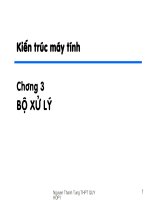Kiến trúc máy tính - P12-2 pps
Bạn đang xem bản rút gọn của tài liệu. Xem và tải ngay bản đầy đủ của tài liệu tại đây (156.55 KB, 16 trang )
Sorting 1
Hàng đợi ưu tiên (Priority Queues)
Sorting 2
Cấu trúc dữ liệu ưu tiên
•
Giả sử rằng mức độ ứu tiên thể hiện
bằng số
•
Cũng có thể là một đối tượng bất kỳ,
nhưng chúng có thể so sánh được với nhau
•
Giá trị nhỏ nhất có mức ưu tiên cao
nhất
•
Các giá trị khác là như nhau
Sorting 3
Hàng đợi ưu tiên (Priority queue)
Là cấu trúc dữ liệu cho việc lưu trữ mọt tập
các phần tử có ion of prioritized elements
Hỗ trợ chèn thêm phần tử bất kỳ
Hỗ trợ loại bỏ phần tử với mức ưu tiên cao
nhất tại bất kỳ thời điểm nào.
Không như những cấu trúc dữ liệu dựa trên
địa chỉ (stacks queues) vì nó không định
nghĩa vị trí cho người sử dụng
Sorting 4
Cài đặt
Bằng danh sách – Đơn giản nhưng
không hiệu quả
Bằng cây heap – hiệu quả hơn (thời
gian yêu cầu là hàm log)
Sorting 5
Hàng đợi ưu tiên ADT
Một hàng đợi ưu tiên lưu trữ
một tập các phần tử
Mỗi phần tử là một cặp
(key, value)
Các phương thức chính của
Hàng đợi ưu tiên ADT
insert(k, x)
Chèn một phần tử với khóa
k và giá trị x
removeMin()
Loại bỏ và trả lại phần tử có
khóa nhỏ nhất
Thêm vào một số phương
thức
min()
trả lại phần tử có khóa nhỏ
nhất nhưng không loại bỏ
nó đi
size(), isEmpty()
Các ứng dụng:
Các máy bay dự phòng
Đấu giá
Thị trường chứng khoán
(Stock market)
Sorting 6
Quan hệ thứ tự toàn phần
Các khóa trong hàng
đợi ưu tiên có thể là
các đối tượng bất kỳ
và trên nó được định
nghĩa một thứ tự
Hai phần tử phân
biệt trong một hàng
đợi ưu tiên có thể có
khóa giống nhau
Các khái niệm toán học
về quan hệ thự tự ≤
toàn phần
T/c phản xạ:
x ≤ x
T/c phẩn đối xứng:
x ≤ y ∧ y ≤ x ⇒ x = y
T/c bắc cầu:
x ≤ y ∧ y ≤ z ⇒ x ≤ z
Sorting 7
Phần tử ADT (§ 7.1.2)
Một phần tử trong
hàng đợi ưu tiên đơn
giản là một cặp key-
value.
Hàng đợi ưu tiên lưu
trữ các cặp cho phép
thêm vào và loại bỏ đi
dựa trên các khóa.
Các phương thức:
key(): trả lại giá trị khóa
của phần tử
value(): trả lại giá trị của
phần tử
Cài đặt trong C++
template <class Object1,
class Object2>
class Entry {
private:
Object1 value;
Object2 key;
public:
Object key();
Object value();
};
Sorting 8
Toán tử so sánh ADT (§ 7.1.2)
A comparator encapsulates
the action of comparing two
objects according to a given
total order relation
A generic priority queue
uses an auxiliary
comparator
The comparator is external
to the keys being compared
When the priority queue
needs to compare two keys,
it uses its comparator
The primary method of the
Comparator ADT:
compare(x, y): Returns an
integer
i
such that
i <
0 if
a
< b
,
i
= 0 if
a
=
b
, and
i >
0
if
a > b
; an error occurs if
a
and
b
cannot be compared.
Sorting 9
Example Comparator
Lexicographic comparison of 2-D
points:
/** Comparator for 2D points under the
standard lexicographic order. */
public class Lexicographic implements
Comparator {
int xa, ya, xb, yb;
public int compare(Object a, Object b)
throws ClassCastException {
xa = ((Point2D) a).getX();
ya = ((Point2D) a).getY();
xb = ((Point2D) b).getX();
yb = ((Point2D) b).getY();
if (xa != xb)
return (xb - xa);
else
return (yb - ya);
}
}
Point objects:
/** Class representing a point in the
plane with integer coordinates */
public class Point2D {
protected int xc, yc; // coordinates
public Point2D(int x, int y) {
xc = x;
yc = y;
}
public int getX() {
return xc;
}
public int getY() {
return yc;
}
}
Sorting 10
Priority Queue Sorting (§ 7.1.4)
We can use a priority
queue to sort a set of
comparable elements
1. Insert the elements one
by one with a series of
insert operations
2. Remove the elements in
sorted order with a series
of removeMin operations
The running time of this
sorting method depends on
the priority queue
implementation
Algorithm PQ-Sort(S, C)
Input sequence S, comparator C
for the elements of S
Output sequence S sorted in
increasing order according to C
P ← priority queue with
comparator C
while ¬S.isEmpty ()
e ← S.removeFirst ()
P.insert (e, 0)
while ¬P.isEmpty()
e ← P.removeMin().key()
S.insertLast(e)
Sorting 11
Sequence-based Priority Queue
Implementation with an
unsorted list
Performance:
insert takes O(1) time
since we can insert the
item at the beginning or
end of the sequence
removeMin and min take
O(n) time since we have
to traverse the entire
sequence to find the
smallest key
Implementation with a
sorted list
Performance:
insert takes O(n) time
since we have to find the
place where to insert the
item
removeMin and min take
O(1) time, since the
smallest key is at the
beginning
4 5 2 3 1 1 2 3 4 5
Sorting 12
Selection-Sort
Selection-sort is the variation of PQ-sort where the
priority queue is implemented with an unsorted
sequence
Running time of Selection-sort:
1. Inserting the elements into the priority queue with n insert
operations takes O(n) time
2. Removing the elements in sorted order from the priority
queue with n removeMin operations takes time
proportional to
1 + 2 + …+ n
Selection-sort runs in O(n
2
) time
Sorting 13
Selection-Sort Example
Sequence S Priority Queue P
Input: (7
,
4
,
8
,
2
,
5
,
3
,
9) ()
Phase 1
(a) (4
,
8
,
2
,
5
,
3
,
9) (7)
(b) (8
,
2
,
5
,
3
,
9) (7
,
4)
. . .
(g) () (7
,
4
,
8
,
2
,
5
,
3
,
9)
Phase 2
(a) (2) (7
,
4
,
8
,
5
,
3
,
9)
(b) (2
,
3) (7
,
4
,
8
,
5
,
9)
(c) (2
,
3
,
4) (7
,
8
,
5
,
9)
(d) (2
,
3
,
4
,
5) (7
,
8
,
9)
(e) (2
,
3
,
4
,
5
,
7) (8
,
9)
(f) (2
,
3
,
4
,
5
,
7
,
8) (9)
(g) (2
,
3
,
4
,
5
,
7
,
8
,
9) ()
Sorting 14
Insertion-Sort
Insertion-sort is the variation of PQ-sort where the
priority queue is implemented with a sorted
sequence
Running time of Insertion-sort:
1. Inserting the elements into the priority queue with n
insert operations takes time proportional to
1 + 2 + …+ n
2. Removing the elements in sorted order from the priority
queue with a series of n removeMin operations takes
O(n) time
Insertion-sort runs in O(n
2
) time
Sorting 15
Insertion-Sort Example
Sequence S Priority queue P
Input: (7
,
4
,
8
,
2
,
5
,
3
,
9) ()
Phase 1
(a) (4
,
8
,
2
,
5
,
3
,
9) (7)
(b) (8
,
2
,
5
,
3
,
9) (4
,
7)
(c) (2
,
5
,
3
,
9) (4
,
7
,
8)
(d) (5
,
3
,
9) (2
,
4
,
7
,
8)
(e) (3
,
9) (2
,
4
,
5
,
7
,
8)
(f) (9) (2
,
3
,
4
,
5
,
7
,
8)
(g) () (2
,
3
,
4
,
5
,
7
,
8
,
9)
Phase 2
(a) (2) (3
,
4
,
5
,
7
,
8
,
9)
(b) (2
,
3) (4
,
5
,
7
,
8
,
9)
. . .
(g) (2
,
3
,
4
,
5
,
7
,
8
,
9) ()
Sorting 16
In-place Insertion-sort
Instead of using an
external data structure,
we can implement
selection-sort and
insertion-sort in-place
A portion of the input
sequence itself serves as
the priority queue
For in-place insertion-sort
We keep sorted the initial
portion of the sequence
We can use swaps
instead of modifying the
sequence
5 4 2 3 1
5 4 2 3 1
4 5 2 3 1
2 4 5 3 1
2 3 4 5 1
1 2 3 4 5
1 2 3 4 5









